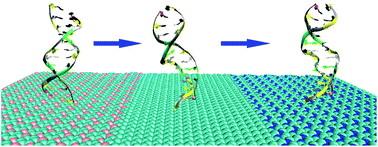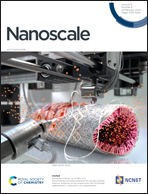Orientational DNA binding and directed transport on nanomaterial heterojunctions†
Abstract
A deep understanding of the interactions between nanomaterials and biomolecules is critical for biomedical applications of nanomaterials. In this paper, we study the binding patterns, structural stabilities and diffusions of a double stranded DNA (dsDNA) segment on two recently reported graphene derivatives, boronic graphene (BC3) and nitrogenized graphene (C3N), with molecular dynamics (MD) simulations. Our results demonstrate that dsDNA exhibits a highly favored binding mode with an upright orientation on BC3 and C3N, independent of the initial configurations. In contrast to graphene (GRA) which demonstrates a cytotoxic feature, BC3 and C3N show high biocompatibility without causing evident structural distortions to the dsDNA duplex, benefitting from the periodic atomic charge distributions. Most interestingly, highly directional dsDNA transport is realized by formation of BC3/GRA and C3N/GRA in-plane heterojunctions, where the dsDNA migrating direction is uniformly BC3 → GRA → C3N. Furthermore, free energy profiling calculated by the umbrella sampling technique quantitatively supports these observations. Insights from our study would potentiate and guide future studies of graphenic 2D materials and bring about a flourishing new branch of in-plane heterojunction applications as targeted drug delivery templates in biomedical research.

- This article is part of the themed collection: Theoretical Modelling at Nano-bio Interfaces


 Please wait while we load your content...
Please wait while we load your content...